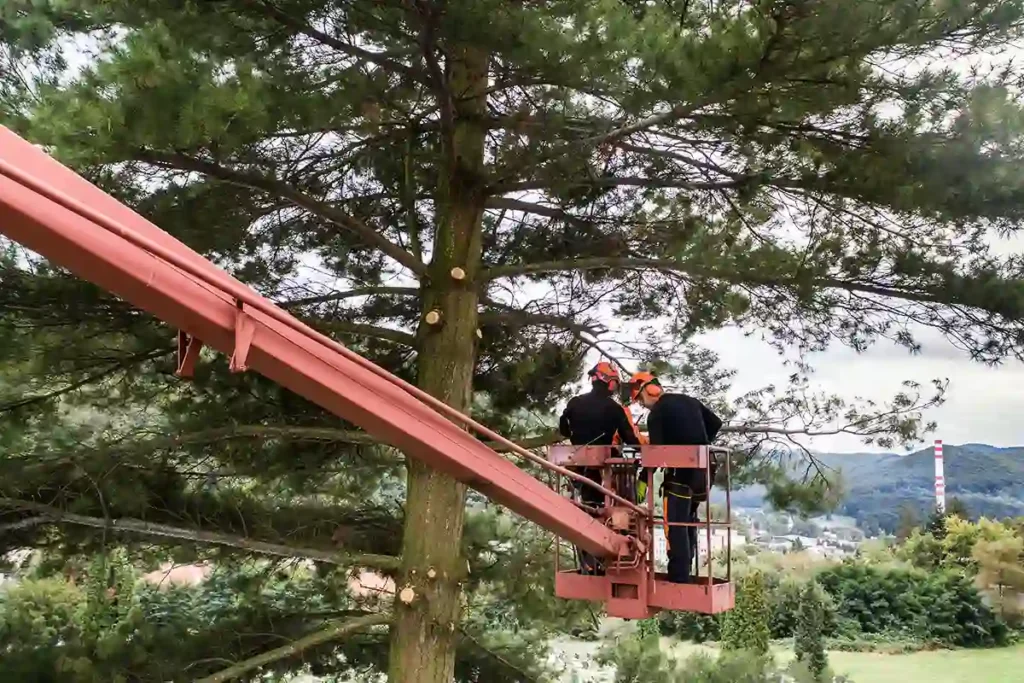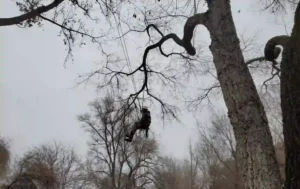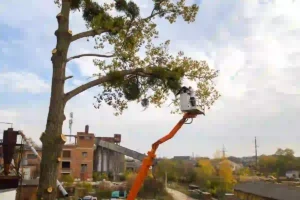Tree maintenance services include pruning, health inspections, disease and pest treatment, fertilization, structural support systems, and hazard removal. The work keeps trees healthy and prevents expensive emergencies. Regular maintenance also costs way less than waiting until major problems develop.
A tree maintained every two years might cost $300 per visit. That same tree ignored for a decade could need $1,800 in corrective work. Or removal at $4,000. Plus replacement costs if you want another tree there.

What Gets Done During Tree Maintenance Service
Pruning removes dead, diseased, or damaged branches before they fall and cause problems. Crown thinning improves air circulation through the canopy. Reduces disease pressure. Crown raising lifts lower branches away from buildings, sidewalks, driveways. Crown reduction makes trees smaller when they’ve outgrown their space.
Health inspections happen before visible problems emerge. Arborists look for early disease signs. Pest activity. Structural weaknesses in branch unions. Root problems that affect stability. Catching issues early costs hundreds to fix. Catching them late costs thousands or requires removal.
Disease treatment depends completely on what’s wrong with the tree. Fungal infections might need affected areas removed, fungicide applications, better drainage around roots. Bacterial problems require cutting out infected tissue and sterilizing tools between every single cut to prevent spread. Viral diseases have no treatment at all. Prevention through proper maintenance is the only option.
Pest management targets insects and organisms damaging the tree. Treatments include insecticides, releasing beneficial predator insects, physical barriers around trunks, or removing infested branches. Some pests like emerald ash borer require preventive treatment before they even show up. Once they’re in the tree, treatment almost never works. The tree dies.
Fertilization adds nutrients urban soils don’t provide naturally. Forest soils have decomposing organic matter that feeds trees continuously. Lawn and landscape soils don’t. Trees planted in turf areas compete with grass for nutrients and usually lose. Proper fertilization improves health, growth, disease resistance. Wrong fertilization burns roots and wastes money.
Cabling and bracing support trees with structural weaknesses. Split trunks. Weak branch attachments. Heavy limbs growing at bad angles. Steel cables and flexible bracing reduce stress on problem areas. The tree lives longer instead of splitting apart during the next storm.
Mulching keeps soil moist. Moderates temperature swings. Prevents weeds from stealing nutrients. Adds organic matter as it breaks down. Proper depth is two to four inches. Keep it back from the trunk by several inches. Too much mulch or mulch touching the trunk causes rot and invites pests.
Root management fixes problems from construction damage, soil compaction, roots circling the trunk (girdling roots), or roots buckling sidewalks. Solutions include careful root pruning, breaking up compacted soil, using air tools to expose roots without cutting them, or installing barriers to redirect root growth away from hardscapes.
Why Any of This Matters
Mature trees add serious value to property. Studies show 5-20% higher sale prices for homes with mature, maintained trees versus homes without. On a $200,000 house, that’s $10,000 to $40,000 in added value. Just from trees.
Neglected trees become dangerous. Dead branches hang overhead for months or years before finally dropping. Usually during storms when you’re not expecting it. Diseased trees develop hidden structural weaknesses. One strong wind and they come down on houses, cars, people.
Costs compound fast when maintenance gets delayed. A diseased branch caught early might cost $150 to remove. Let that disease spread and you’re looking at $2,000 for extensive treatment. Or complete removal at $3,500 plus $2,000 to plant a replacement. That’s $5,500 instead of $150.
Insurance companies care about maintenance records. Dead branch falls on your neighbor’s fence because you ignored it for two years? Your insurance might deny the claim for negligence. Then you’re paying out of pocket for their repairs plus potentially a lawsuit.
Emergency tree work after storms costs double normal rates. Sometimes more. Tree services know you can’t wait or shop around when a tree is against your house. They charge accordingly. Premium rates for emergency response.
Timing for Different Tree Maintenance Services
Pruning frequency varies by species and age. Young trees benefit from light annual pruning to develop good structure. Mature trees typically need pruning every two to five years. Fast-growing species like silver maples need more frequent work than slow-growing oaks.
Health inspections should happen annually for valuable specimens or trees near structures. Less critical trees might only need inspection every few years. But any sudden changes (wilting leaves, unusual discoloration, excessive deadwood, visible pest activity) require immediate inspection regardless of schedule.
Disease treatment timing depends on the specific disease. Some treatments only work during dormancy. Others require application during active growth. Some diseases need preventive treatment before symptoms even appear. Miss the window and you wait another year or accept that treatment won’t work.
Pest management follows pest life cycles. Most insecticides only work during specific developmental stages. Adult beetles might be immune while larvae are vulnerable. Timing matters enormously. Regular monitoring catches pest problems when treatment is still effective.
Fertilization usually happens once or twice per year. Spring feeding supports active growth. Fall feeding helps trees store nutrients for winter dormancy and early spring growth. Soil testing every couple years shows actual nutrient deficiencies instead of guessing what the tree needs.
Cabling and bracing systems are permanent installations but need inspection every two or three years. Cables stretch over time. Hardware corrodes or works loose. Regular checks prevent failures.
Mulch needs refreshing annually or twice a year as it decomposes and breaks down. Add fresh material after removing any excessive buildup. Don’t just pile new mulch on top of old mulch year after year. That creates depths that suffocate roots.
Root work happens as needed. Construction projects damaging roots. New hardscapes going in. Visible buckling or heaving from aggressive roots. Annual inspections can spot developing problems before they require expensive fixes.
What This Actually Costs
Small trees under 25 feet run $150-$400 for maintenance pruning. Health inspection and basic treatment adds $100-$200 if problems are found.
Medium trees (25-50 feet) cost $400-$800 for pruning. Health services add another $150-$300 depending on what’s discovered during inspection.
Large trees (50-75 feet) hit $800-$1,500 for pruning work. Complex health issues can add $200-$500 in treatment costs on top of that.
Extra large trees over 75 feet easily reach $1,500-$3,000 just for pruning. Health treatments might add another $500-$1,000 for serious problems.
Cabling and bracing installations range from $200-$800 per tree. Simple single-cable systems on the low end. Complex multi-cable systems with rigid bracing on the high end.
Fertilization runs $50-$200 per tree based on size and application method. Surface application is cheapest. Deep root injection costs more but gets nutrients where they’re needed most effectively.
Pest treatments cost $100-$500 depending on tree size, pest species, and treatment method. Preventive treatments for emerald ash borer or similar serious threats run $150-$300 annually for large trees.
Before getting any estimates, use treetrimmingcostcalculator.com. Enter your tree height, species, location, accessibility details. The calculator gives realistic baseline pricing for your area. Then when estimates arrive you know if someone’s overcharging by 40% or suspiciously cheap in ways that signal problems.
Maintenance Plans vs Paying Per Visit
Some tree services offer annual maintenance plans. Multiple scheduled visits throughout the year. Plans usually cost less per visit than individual service calls. They also ensure proper seasonal timing for treatments.
Typical plan includes spring inspection and fertilization. Summer pest monitoring. Fall structural pruning. Priority response for storm emergencies. Plans run $300-$800 annually for small residential properties with a few trees. Larger properties with multiple mature specimens might hit $1,000-$3,000 per year.
Individual service calls cost more per visit but offer flexibility. Only pay for services when you actually need them. Works better for properties requiring minimal maintenance.
Do the math on break-even. Annual plan costs $650 and includes services you’d pay $900 for separately? Plan saves money. Plan costs $650 but you’d only buy $400 worth of services individually? Skip the plan. Pay as needed.
Mistakes Property Owners Keep Making
Waiting until problems are obvious before calling someone. Visible symptoms mean the problem is already advanced. Early intervention catches issues when treatment is cheap and effective. Late intervention means expensive fixes or removal.
Choosing tree services based purely on price. Lowest bidder often means untrained crews. Poor technique. Missed problems that create bigger issues later. Fixing those mistakes costs more than proper maintenance would have.
Skipping inspections between pruning appointments. Trees can decline significantly in two or three years. Diseases establish. Pests move in. Structural problems develop. Annual inspections catch these during manageable stages.
Over-mulching kills more trees than people realize. Mulch piled high against trunks looks neat. It causes root rot, attracts pests, creates fungal problems. That mulch volcano look is actively harmful despite being everywhere in commercial landscapes.
Topping trees to control height creates permanent damage. Topped trees develop weak branch unions. They become more hazardous after topping than before. Proper crown reduction maintains structure while reducing size. Topping destroys structure.
Ignoring species-specific requirements. Oak trees need different care than pines. Fruit trees need different timing than ornamentals. Treating all trees the same wastes money on wrong treatments and misses necessary treatments.
DIY work on anything over 15 feet tall. Professional equipment and training prevent injuries and tree damage. Poor cuts from unstable ladder positions cause long-term decline. People die doing tree work every year. Falls, chainsaw accidents, electrocution from power lines.
How to Choose a Maintenance Provider
Look for ISA certified arborists on staff. International Society of Arboriculture certification proves knowledge of tree biology, diseases, proper techniques. Verify certification numbers on their website. Some companies claim certification without actually having it.
Verify current insurance before anything else. General liability covers property damage. Workers’ compensation covers employee injuries. Both policies must be current with adequate limits. Get actual certificates with policy numbers and dates. Then call the insurance company to confirm coverage is active. Some contractors show expired certificates or fake ones.
Check references from customers with similar properties. Call those references. Ask specific questions about work quality, communication, reliability, whether they’d hire the company again. Don’t just collect phone numbers and skip the calls.
Read reviews across multiple platforms. Google, Better Business Bureau, Yelp if available. Look for patterns. One or two complaints happen to everyone. Dozens of complaints about the same issues (surprise charges, property damage, incomplete work) indicate systemic problems.
Get detailed written service agreements. Exactly what services get performed. When they happen. What’s included. What costs extra. Vague agreements like “tree maintenance – $500” provide no useful information.
Compare pricing against treetrimmingcostcalculator.com baselines. Extremely low prices mean cut corners somewhere. Extremely high prices need detailed explanations for the premium.
Long-Term Financial Reality
Regular maintenance might total $500-$800 annually for typical residential properties. Over ten years that’s $5,000-$8,000 invested in tree care.
Neglecting maintenance seems free initially. Eventually the accumulated problems require $12,000-$20,000 in corrective work, emergency services, and removals. The “free” approach costs more.
Maintained trees increase property value. Neglected trees decrease value. Financial benefit compounds over years through both cost avoidance and value preservation.
Removal and replacement costs dramatically more than maintenance. Removing a large tree runs $2,500-$5,000. Replacing it with a mature specimen costs another $1,500-$3,000. That’s $4,000-$8,000 that proper maintenance could have prevented.
Property damage from tree failure reaches tens of thousands easily. Large tree through a roof might cause $50,000 in structural damage. Insurance denials for negligent maintenance mean you pay everything out of pocket.
Personal injury creates massive liability. Medical bills, lost wages, pain and suffering settlements can hit $100,000 or more. Regular maintenance prevents these catastrophic risks entirely.
Seasonal Timing Matters
Spring is optimal for pruning before active growth starts. Inspections catch winter damage and emerging problems. Fertilization supports the growing season ahead.
Summer focuses on pest and disease monitoring. Many treatments only work during summer months when pests are in vulnerable life stages. Watering during drought prevents permanent damage to stressed trees.
Fall prepares trees for winter stress. Structural pruning reduces storm damage risk. Late fertilization helps trees store nutrients for dormancy. Removing dead branches prevents ice load failures.
Winter provides clear visibility for structural assessment without leaves blocking the view. Dormant pruning works well for most species. Prices often drop 20-30% during slow winter season.
Schedules need alignment with specific tree species and local climate. Generic cookie-cutter schedules ignore critical variables and reduce effectiveness.
Making This Work Financially
Budget for tree maintenance like roof maintenance or HVAC service. Recurring necessary expense for valuable property features. Not optional if you want to preserve value.
Schedule work during off-peak seasons. Winter and early spring offer significant savings compared to peak summer demand. Same work, lower price.
Bundle multiple trees in single visits. Mobilization costs get distributed across multiple trees instead of charged per tree. Per-tree cost drops.
Fix small problems immediately. $200 today prevents $2,200 next year. The math is simple but most people ignore it until forced to spend the larger amount.
Keep detailed records of all maintenance. Proves proper care to insurance companies. Provides history when new arborists take over. Tracks long-term health trends for each specimen.
Tree maintenance services represent preventive care protecting valuable assets. Regular maintenance costs substantially less than neglect. Properties with maintained trees are safer, more valuable, and avoid expensive emergencies. Understanding maintenance needs, realistic costs, and proper provider selection creates long-term value exceeding the required investment.



